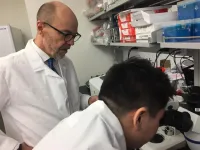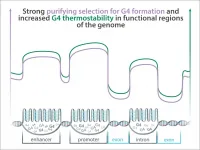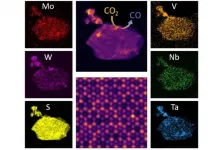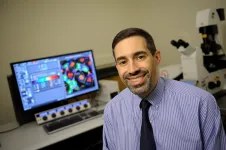(Press-News.org) Irvine, Calif., June 29, 2021 - Fireworks are synonymous in the United States with the celebration of Independence Day and other special events, but the colorful displays have caused a growing risk to public safety in recent years, according to a study by environmental health researchers at the University of California, Irvine.
Relying on real-time air quality measurements crowdsourced from a network of more than 750 automated sensors distributed throughout California, scientists from UCI's Program in Public Health found that short-term, extremely high-particulate-matter air pollution from the widespread use of fireworks spiked during the periods of late June through early July in 2019 and 2020.
The increase was most pronounced in Southern California counties where fireworks regulations are less strict than in northern parts of the state and where the illegal use of do-it-yourself pyrotechnics is also more prevalent. This and other findings are the subject of a study published recently in the International Journal of Environmental Research and Public Health.
"You may have seen discussions on social media lately about people worrying for their pets on nights when the skies are filled with exploding fireworks, but we've found that there is a real threat to human well-being too," said co-author Jun Wu, UCI professor of public health. "And like many other environmental justice issues, we find the worst impacts among residents of low-income communities."
Aerial explosions cause the release of fine particles less than 2.5 micrometers in diameter. Airborne particulate matter of this size is hazardous because when inhaled, it can be absorbed by the lungs and passed to other tissues inside the body. Fireworks get their distinct colors from compounds containing barium, copper, magnesium, potassium and strontium. As rockets burst in the sky, they release these chemicals, trace redox-active metals and water-soluble ions, which inevitably fall on those below.
"These fine particles are known to cause a wide range of adverse health effects, including premature mortality, respiratory and cardiovascular diseases, adverse pregnancy outcomes, and neurological diseases," Wu said.
The UCI team used data accumulated via a statewide network of PurpleAir sensors, low-cost devices deployed in households. Utilizing this method, the researchers built a high-resolution map tracking levels of airborne particulate matter less than 2.5 micrometers in diameter before, during and after Fourth of July fireworks during the study period.
"The PurpleAir network includes sensors that monitor air continuously, which offers advantages over the traditional monitoring installations that are often positioned away from residential areas and take intermittent measurements that may miss peak days such as the Fourth of July," said lead author Amirhosein Mousavi, a postdoctoral scholar in UCI's Program in Public Health. "By taking data from a large, distributed sensor network that's always collecting data in neighborhoods where people from various socioeconomic profiles live, we were able to get a much clearer characterization of the health risks posed by do-it-yourself fireworks."
The team found that among all 58 California counties, Los Angeles County experienced the highest daily PM2.5 levels around the Fourth of July holiday in both 2019 and 2020. They believe this was the result of larger numbers of individuals shooting off their own rockets in neighborhoods where they lived, as well as the nature of L.A.'s topography, which has long been known to facilitate the buildup of air pollution.
In addition, researchers believe they detected a COVID-19 effect in their data. PM2.5 concentrations on July 4 and 5 in 2020 were, on average, 50 percent higher than in 2019, likely due to the increased use of household-level fireworks during the pandemic lockdowns.
The team also learned that peak fireworks pollution was two times higher in communities with lower socioeconomic status, larger minority-group populations and higher asthma rates.
"This work highlights the important role that policy and enforcement can play in reducing fireworks-related air pollution and protecting public health," Wu said. "As there is a patchwork of different restrictions and regulations regarding fireworks in our state, it's clear that a more coordinated approach would help people breathe easier during times of celebration."
INFORMATION:
Besides Wu and Mousavi, the study included Yiting Yuan and Shahir Masri of UCI's Program in Public Health and Greg Barta from the SciVfx Initiative in London. Funding was provided by the U.S. National Institutes of Health.
About the University of California, Irvine: Founded in 1965, UCI is the youngest member of the prestigious Association of American Universities and is ranked among the nation's top 10 public universities by U.S. News & World Report. The campus has produced three Nobel laureates and is known for its academic achievement, premier research, innovation and anteater mascot. Led by Chancellor Howard Gillman, UCI has more than 36,000 students and offers 224 degree programs. It's located in one of the world's safest and most economically vibrant communities and is Orange County's second-largest employer, contributing $7 billion annually to the local economy and $8 billion statewide. For more on UCI, visit http://www.uci.edu.
Media access: Radio programs/stations may, for a fee, use an on-campus ISDN line to interview UCI faculty and experts, subject to availability and university approval. For more UCI news, visit news.uci.edu. Additional resources for journalists may be found at communications.uci.edu/for-journalists.
This lobster tale begins a few years ago when the proprietor of a northeastern seafood restaurant publicly asserted that exposing lobsters to a little cannabis prior to cooking produced notable changes in their behavior and a less dramatic scene in the kitchen for all concerned, which was the Maine thing.
In a paper published online June 29, 2021 in the journal Pharmacology Biochemistry and Behavior, a team led by researchers at University of California San Diego School of Medicine, report on efforts to answer that burning, boiling and baked question. They obtained live lobsters (Homarus americanus) from a supermarket and exposed the crustaceans to up to 60 minutes of vaporized Δ9-tetrahydrocannabinol (THC) -- the principle psychoactive component of cannabis -- then ...
June 29, 2021 - Nutley, NJ - Scientists from the Hackensack Meridian Center for Discovery and Innovation, working with collaborators from across the globe, uncovered the mechanism of action of a novel anti-tuberculosis drug that they have helped develop.
The new findings show how the enzyme inhibitor triaza-coumarin, or TA-C, is metabolized by the TB germs, which makes it effective in inhibiting the disease from within, like in a "Trojan horse" attack, according to the new paper in the journal Proceedings of the National Academy of Sciences.
"This is a promising new direction of research," said Thomas Dick, member of the CDI faculty. "We are hoping this work can make a difference in the ongoing fight against TB."
"The scientists at the CDI who specialize in ...
For many years, researchers have been focused on developing technologies that can help us fight the imminent climate change crisis. They have one goal in common: finding sustainable energy sources that can replace the environmentally toxic fossil fuels. "Photocatalysts" that drive an artificial process that replicates photosynthesis (in which solar energy is converted to useful materials) are promising in this regard, given that we are able to develop the technology needed for them. Crystalline materials, such as strontium titanate (SrTiO3), which can serve as "photocatalysts" in solar devices, can lead us in the direction.
SrTiO3 is attractive owing to various other reasons ...
Basic needs of disaster- and conflict-impacted refugees are often met by humanitarian relief goods and services, and until now little was known about how refugees create economic livelihood beyond immediate relief.
A new exploratory case study from Portland State University Associate Professor of Management Theodore Khoury reveals how Syrian refugees in the Za'atari camp reached beyond basic disaster relief support and leveraged social capital to create informal economic systems that helped improve their quality of life. The study, "Towards a theory of informal supply networks: An?exploratory case study of the Za'atari refugee camp," is published in the Journal of Operations Management and co-authored by ...
PHILADELPHIA - The use of e-cigarettes, or vaping, causes serious damage to the lungs. After the novel coronavirus responsible for the respiratory disease COVID-19 emerged last year, there have been ongoing concerns about how vaping might impact risk of infection and severity of symptoms. Some evidence shows an increased risk of COVID-19 among those who vape. Research also shows a higher COVID-19 mortality rate in men compared to women, and men are more likely to vape than women. However, there is no evidence to link these two observations.
New research from Jefferson sheds light on this by showing that exposure to e-cigarette vapor increases levels of the coronavirus receptor in the lungs ...
A 50% rise in the level of carbon dioxide (CO2) in the atmosphere could reduce rainfall in the Amazon as much as or even more than substitution of the entire forest by pasture. The rise in CO2 would reduce the amount of water vapor emitted by the forest, leading to a 12% annual drop in the volume of rainfall, while total deforestation would reduce rainfall by 9%.
These estimates are presented in a study published in Biogeosciences by scientists affiliated with the National Space Research Institute (INPE), the University of São Paulo (USP) and the University of Campinas (UNICAMP) in Brazil, and with Munich Technical University (TUM) in Germany.
“CO2 is a basic input for photosynthesis, so when it increases in the atmosphere, plant physiology ...
Some regions of the human genome where the DNA can fold into unusual three-dimensional structures called G-quadruplexes (G4s) show signs that they are preserved by natural selection. When G4s are located in the regulatory sequences that control how genes are expressed or in other functional, but non-protein coding, regions of the genome, they are maintained by selection, are more common, and their unusual structures are more stable, according to a new study. Conversely, the structures are less common, less stable, and evolve neutrally outside of these regions, including within the protein-coding regions of genes themselves.
Together, these ...
A two-dimensional alloy material -- made from five metals as opposed to the traditional two -- has been developed by a collaboration between researchers at the McKelvey School of Engineering at Washington University in St. Louis and researchers at the College of Engineering at the University of Illinois at Chicago.
And, in a first for such a material, it has been shown to act as an excellent catalyst for reducing CO2, into CO, with potential applications in environmental remediation.
The research, from the lab of Rohan Mishra, assistant professor in the Department of Mechanical Engineering & Materials Science at ...
A team of neuroscientists at the Beckman Institute for Advanced Science and Technology led by Baher Ibrahim and Dr. Daniel Llano published a study in eLife that furthers our understanding of how the brain perceives everyday sensory inputs.
"There is a traditional idea that the way that we experience the world is sort of like a movie being played on a projector. All the sensory information that is coming in is being played on our cerebral cortex and that's how we see things and hear things," said Llano, a Beckman researcher and associate professor in the Department of Molecular and Integrative Physiology at the University of Illinois ...
Many drivers use tollways to get from point A to point B because they are a faster and more convenient option. The fees associated with these roadways are higher during peak traffic hours of the day, such as during the commute to and from work. With this structure, drivers who are not adding to the heavy flow of traffic do not have to pay higher toll prices. However, those who utilize the toll road during more congested hours pay a premium to use the faster, more convenient highways.
Similarly, not everyone uses the same amount of electricity throughout the day. There are peak load hours that put more strain on the grid, and there are users within those times who use more electricity ...





